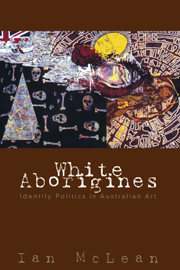Book contents
- Frontmatter
- Contents
- List of Illustrations
- Preface
- Acknowledgments
- 1 Ocean and the Antipodes
- 2 Artful Killings
- 3 The Art of Settlement
- 4 The Bad Conscience of Impressionism
- 5 Aboriginalism and Australian Nationalism
- 6 The Aboriginal Renaissance
- 7 Aboriginality and Contemporary Australian Painting
- 8 Painting for a New Republic
- Postscript: The Wandering Islands
- Notes
- Bibliography
- Index
2 - Artful Killings
Published online by Cambridge University Press: 05 August 2012
- Frontmatter
- Contents
- List of Illustrations
- Preface
- Acknowledgments
- 1 Ocean and the Antipodes
- 2 Artful Killings
- 3 The Art of Settlement
- 4 The Bad Conscience of Impressionism
- 5 Aboriginalism and Australian Nationalism
- 6 The Aboriginal Renaissance
- 7 Aboriginality and Contemporary Australian Painting
- 8 Painting for a New Republic
- Postscript: The Wandering Islands
- Notes
- Bibliography
- Index
Summary
While those drawing up the plan for a penal colony at Botany Bay could refer to the experience of over two hundred years of Western colonisation, the idea of a penal colony as opposed to a colony of free settlers was new and untried. Perhaps this is one reason why the colony's quick transformation into a settler colony was inevitable. However, the main reason was a psychological imperative to find redemption in the Antipodes. This meant that, in its very discovery, the place had to be remade as ocean, as terra nullius, as a site of invasion and Utopia. The colony's limited penal purpose was quickly foreclosed. At the end of 1791 Arthur Phillip advised that New South Wales would only survive if it was a traditional colony of free settlers using convicts as slave labour, and recommended that land be granted to members of the New South Wales Corps to ensure this change. The next year the British government ‘was converted to Phillip's views’. ‘Such’, wrote Hughes, ‘was the germ of the assignment system, the modified form of slavery on which Australia's early economy would be built’. John Black argues that the officers of the New South Wales Corps provided the capital for the colony's economy at a time when such practices were an accepted part of army culture. They ‘were the first entrepreneurs of Australia of whom the Kerry Packers, Michael Edwards and Rupert Murdochs are descendants’.
- Type
- Chapter
- Information
- White AboriginesIdentity Politics in Australian Art, pp. 17 - 33Publisher: Cambridge University PressPrint publication year: 1998

